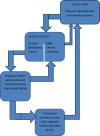Incremental cost of increasing access to maternal health care services: perspectives from a demand and supply side intervention in Eastern Uganda
- PMID: 24976793
- PMCID: PMC4074383
- DOI: 10.1186/1478-7547-12-14
Incremental cost of increasing access to maternal health care services: perspectives from a demand and supply side intervention in Eastern Uganda
Abstract
Introduction: High maternal and infant mortality continue to be major challenges to the attainment of the Millennium Development Goals for many low and middle-income countries. There is now evidence that voucher initiatives can increase access to maternal health services. However, a dearth of knowledge exists on the cost implications of voucher schemes. This paper estimates the incremental costs of a demand and supply side intervention aimed at increasing access to maternal health care services.
Methods: This costing study was part of a quasi-experimental voucher study conducted in two districts in Eastern Uganda to explore the impact of demand and supply - side incentives on increasing access to maternal health services. The provider's perspective was used and the ingredients approach to costing was employed. Costs were based on market prices as recorded in program records. Total, unit, and incremental costs were calculated.
Results: The estimated total financial cost of the intervention for the one year of implementation was US$525,472 (US$1 = 2200UgShs). The major cost drivers included costs for transport vouchers (35.3%), health system strengthening (29.2%) and vouchers for maternal health services (18.2%). The average cost of transport per woman to and from the health facility was US$4.6. The total incremental costs incurred on deliveries (excluding caesarean section) was US$317,157 and US$107,890 for post natal care (PNC). The incremental costs per additional delivery and PNC attendance were US$23.9 and US$7.6 respectively.
Conclusion: Subsidizing maternal health care costs through demand and supply - side initiatives may not require significant amounts of resources contrary to what would be expected. With Uganda's Gross Domestic Product (GDP) per capita of US$55` (2012), the incremental cost per additional delivery (US$23.9) represents about 5% of GDP per capita to save a mother and probably her new born. For many low income countries, this may not be affordable, yet reliance on donor funding is often not sustainable. Alternative ways of raising additional resources for health must be explored. These include; encouraging private investments in critical sectors such as rural transport, health service provision; mobilizing households to save financial resources for preparedness, and financial targeting for the most vulnerable.
Keywords: Costs; Demand-side; Maternal health; Supply-side; Sustainability; Vouchers.
Figures
References
-
- WHO. Making pregnancy safer: the critical role of the skilled attendant. Joint statement. Geneva: World Health Organization; 2004.
-
- Bhatia M, Gorter A. Improving access to reproductive and child health services in developing countries: are competitive voucher schemes an option? J Int Dev. 2007;19(7):975–981. doi: 10.1002/jid.1361. - DOI
LinkOut - more resources
Full Text Sources
Other Literature Sources


